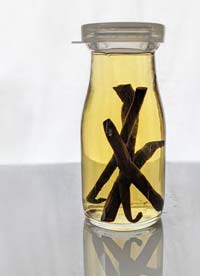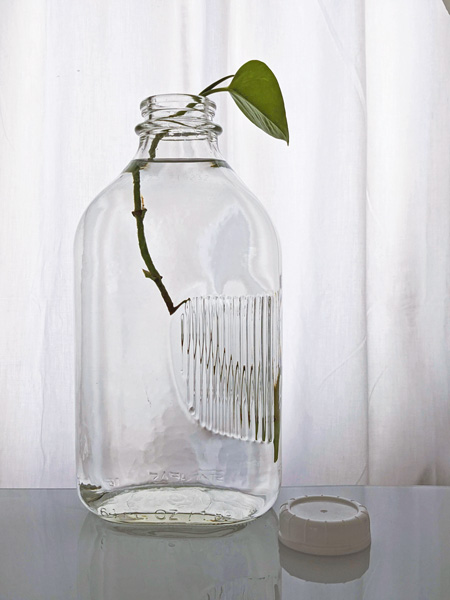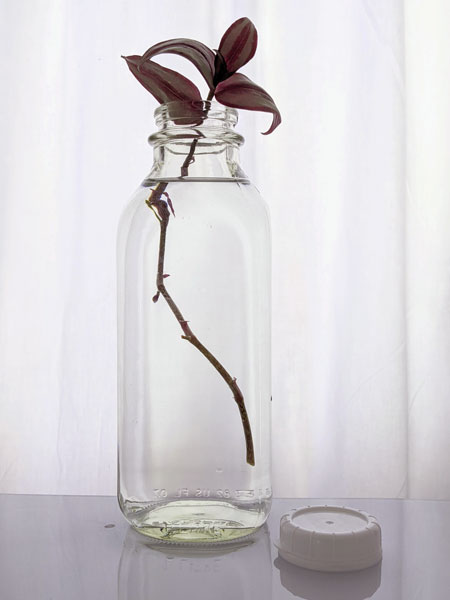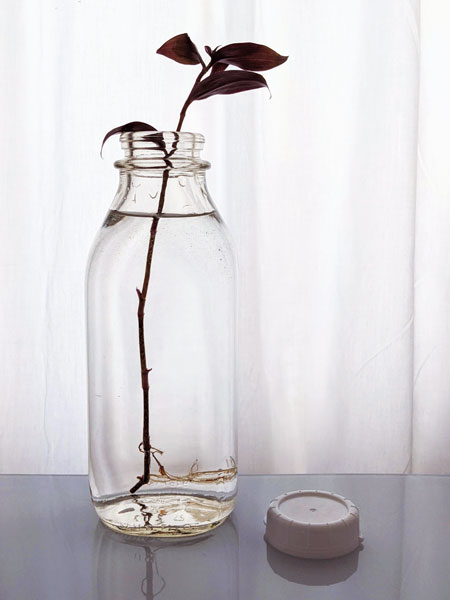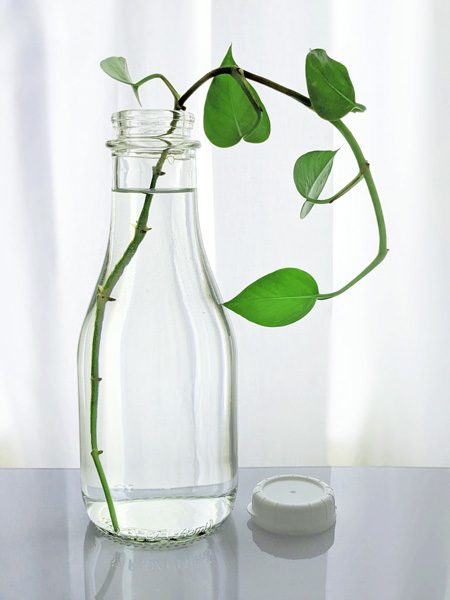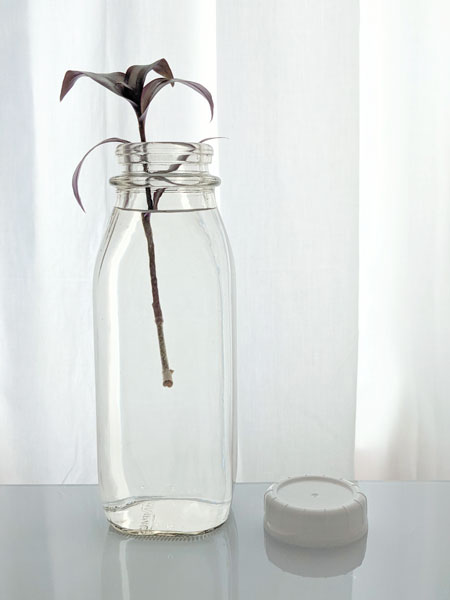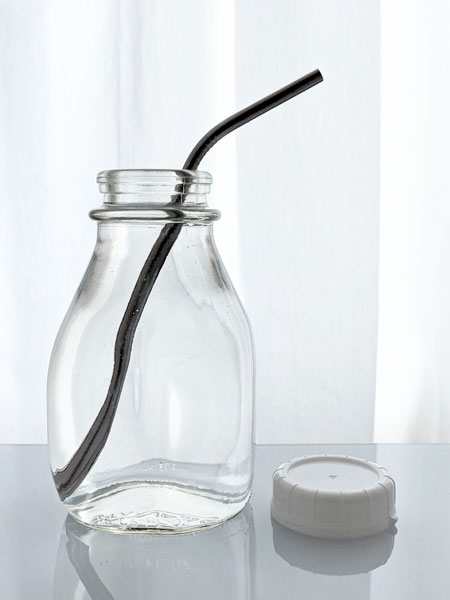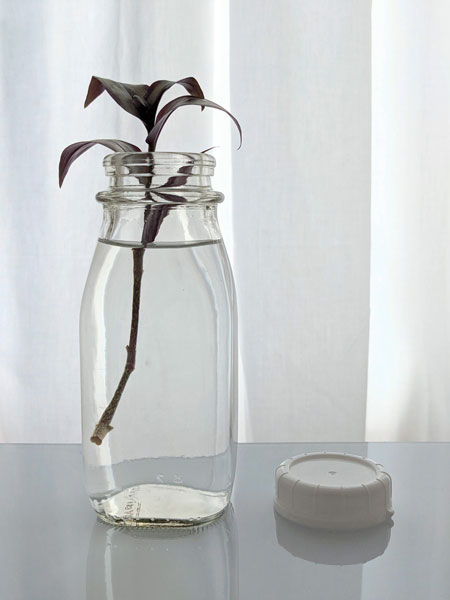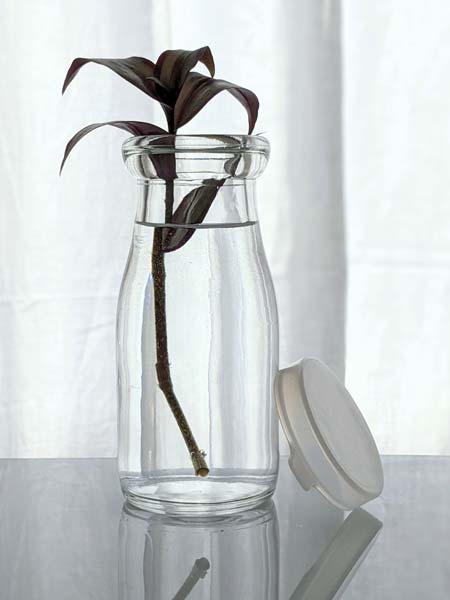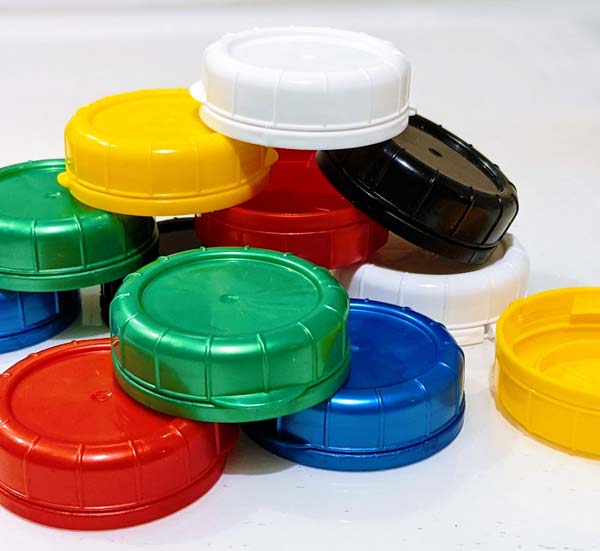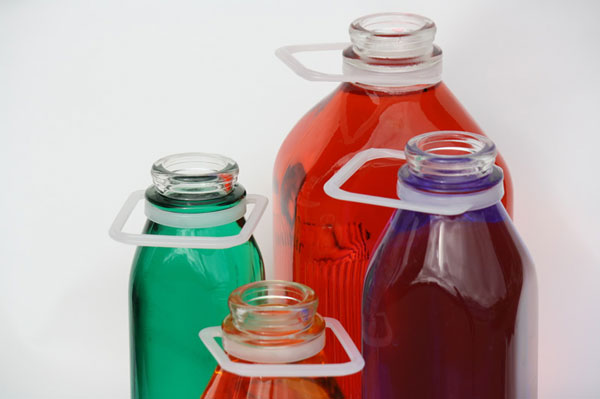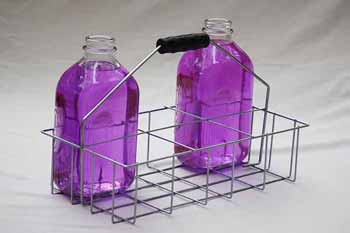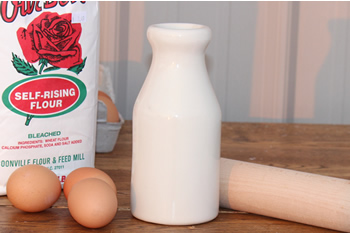Glass Milk Bottles
In Stock. Eight Styles. Ready to Ship. Old fashioned glass milk bottles and caps for sale at Red Hill General Store. Fill these glass milk bottles with milk, juice, candies, nuts, pickled vegetables, oils, spices or any beverage you want. Use them for water, tea, orange juice or lemonade and chill in the refrigerator for a refreshing drink. From everyday glasses to partyware you won't be disappointed in a beautiful set of glass milk bottles. Reusable, dishwasher safe.
Glass Milk Bottles and Milk Bottle Caps are Made in the USA
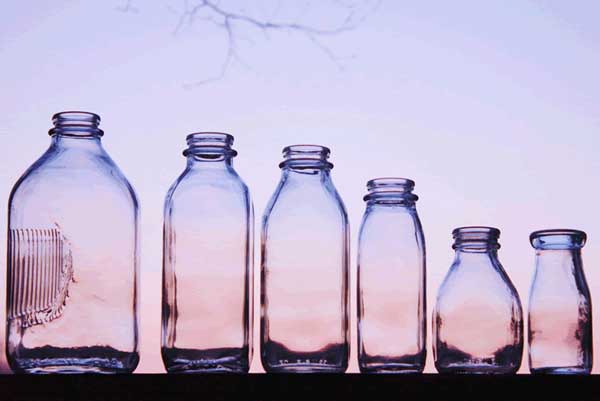
- Clear Glass Milk Bottles
- Available in Single, Small Case Pack & Case Pack Quantities
- Bottles and Caps are Brand New, Not Seconds or Antique Bottles
- Food and Beverage Safe
- All Bottles include Snap On Cap, Caps are BPA Free
- Replacement Milk Bottle Caps are Available and Sold Separately
- Attachable Plastic Handles are Available and Sold Separately
- Wire Milk Bottle Carriers are Available and Sold Separately
- Milk Bottle Brush is Available and Sold Separately
Mini Milk Bottles
(Half Pint Milk Bottle)
Popularized back in the good ol' days for single servings of milk, today these half pint milk bottles are used for many different things from parties to dishware.
Base Diameter: 2 1/4"
Height: 5 3/8"
Bottle Opening: 1 5/8"
Small Glass Milk Bottles
(12 Ounce Glass Milk Bottle)
Popular since the 1940s this glass milk bottle style is a choice 12 ounce single serving size. Smaller than the more popular quart and pint milk bottles, this little glass bottle is great for a children's milk glass or pressed juice for adults.
Base Length: 4 3/4"
Base Width: 2 1/4"
Height: 6"
Bottle Opening: 1 1/4"
Pint Milk Bottles
(Short Pint Glass Milk Bottle)
With a reasonable two cup portion size this pint milk jug is great for strawberry milk, berry smoothies, apple juice, cream soda, salad dressings and lemon tea. Drink a glass of lemonade in the garden, then use it as a small vase for flowers.
Base: 2 7/8"
Height: 5 3/4"
Bottle Opening: 1 1/4"
Pint Glass Milk Bottle
(Tall Pint Milk Bottle)
Sip squeezed juice, iced coffee or a blended smoothie in this old school milk bottle size. Everything tastes better in glass. For a 16-ounce liquid holding capacity, the tall skinny pint milk bottle takes little shelf space.
Base: 2 3/8"
Height: 7 3/8"
Bottle Opening: 1 1/4"
Quart Glass Milk Bottle
When you think of an old fashioned milk bottle this quart milk bottle size and design is it. These quart glass milk bottles with lids make serving and storing milk from your modern ice box simple and uncluttered.
Base: 3"
Height: 8 3/8"
Bottle Opening: 1 1/4"
Quart Glass Milk Bottle
(Round Quart Milk Bottle)
A quart milk bottle made with thick and durable clear glass built for a lifetime of washing and reusing. It's a vintage-inspired milk jug that's easy to maneuver one-handed. A welcome shape for standard fridges or freezers.
Base Diameter: 3 1/4"
Height: 9 5/8"
Bottle Opening: 1 1/4"
1 Liter Glass Milk Bottle
Serve and store homemade beverages like heavy cream, chocolate milk, lemonade, watermelon juice, or a favorite iced tea. The thick milk bottle glass is made for withstanding extreme kitchen temperatures.
Base: 3"
Height: 9 1/4"
Bottle Opening: 1 1/4"
Half Gallon Glass Milk Bottles
Just because home milk delivery is pretty much a thing of the past you can still enjoy milk or any beverage from a durable half gallon glass bottle. The square design and 64oz liquid capacity is especially suited for chilling homemade juices and ice teas in the fridge.
Base Length: 4 3/4"
Base Width: 3 1/2"
Height: 10 1/4"
Bottle Opening: 1 1/4"
Milk Bottle Caps
Milk bottle caps are comaptabile with all our glass milk bottle sizes. These washable and reusable glass milk bottle caps are a BPA-Free thick plastic. Choose six colored caps in red, yellow, green, blue, black or white.
Milk Bottle Handles
These milk bottle handles are a great addition to a set of glass milk bottles. The sturdy and simple plastic design makes it easy to carry individual bottles.
Please note: These handles do not fit on the half pint bottles.
Milk Bottle Knowledgebase
How To Attach A Handle To A Glass Milk Bottle
Handles attach securely around the neck of glass milk bottles for easy carrying. Handles fit all sizes, except the half pint glass bottle. Read these simple instructions for attachment:

Heat a pot of water on the stove. Low to medium heat works fine.

Place plastic handle(s) in hot water for 30 seconds to 1 minute. This will make them flexible, without becoming too hot to manage by hand.
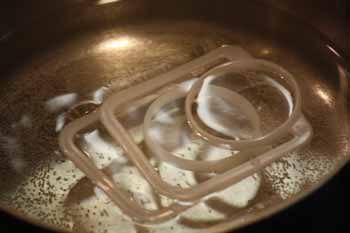
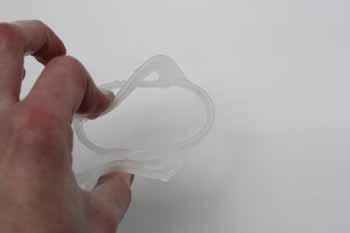
Pop handle over neck of bottle. It will stretch then contract to fit securely.
Allow to cool for a couple minutes. Click here to view our handles.
Why does milk taste better in a glass bottle?
Milk tastes better in a glass milk bottle for a couple of reasons. First off, cold milk is tastier milk, and simply put, glass stays colder than cardboard or plastic. Glass also maintains its cooler temperature longer than other materials. A second, less-known reason for the improved taste of milk in glass, is due to the lack of foreign scents and tastes that are inherent in plastic and cardboard containers.
Is glass bottled milk better?
Glass bottled milk is superior to milk sold in cardboard or plastic containers in several ways. Glass bottled milk often travels a shorter distance, particularly when it is coming directly from a farm. Fresher milk is tastier, more nutritious (less enzymes have been lost due to time and temperature variations,) and more cost-effective. Additionally, a glass milk bottle will maintain a cooler temperature and more efficient seal over time. (A snap-on lid is an effective top for use when refrigerating or freezing milk.) Glass bottled milk also lasts longer and maintains its nutritive qualities longer, resulting in significant cost-saving for the consumer. (This is also true for cow's milk alternatives, including but not limited to: soymilk, almondmilk, and oat milk. Consider transferring plant-based milks to glass milk bottles for refrigerated storage. See below.)
If glass bottled milk is not an option in your area, consider transferring your store-bought milk from its cardboard or plastic container into a glass milk bottle for refrigeration. Be sure to use a clean and dry glass milk bottle, and use a snap-on lid for sealing, after transferring your milk. Place the milk in the back of your fridge to reduce temperature fluctuation and to add to the longevity.
Also of importance, glass bottled milk is better for the environment than it's paper and plastic competitors. Glass bottled milk will travel less distance, from farm to consumer, and will result in decreased fuel and emissions. When no longer of use, glass is, of course, highly recyclable or easily donated for secondhand sale to a new consumer. Glass bottles are also readily and easily reused (store dry goods, create a tincture, or decorate your home.)
Does milk stay fresher in glass bottles?
Milk stays fresher and lasts twice as long when placed in glass milk bottles instead of cardboard containers or plastic jugs. This is true for cow's milk and cow's milk alternatives, including but not limited to: soymilk, almondmilk, and oatmilk. The reason is simple: glass bottles stay colder and maintain a better seal than their paper and plastic counterparts. A snap-on milk bottle cap provides an adequate seal for a refrigerated glass milk bottle that protects the taste, nutrient-content, and freshness of milk. Milk (or plant-based milk alternatives) in cardboard or plastic containers from the grocery store can be safely transferred to clean and dry glass milk bottles for an increase in longevity and improved taste. For enhanced lasting power, be sure to place your glass milk bottle in the back of your fridge where the temperature remains the most constant.
How long does milk stay fresh in milk bottles?
Milk is generally considered fresh and safe for consumption up until the printed expiration date on the provided container. (Proper, continuous storage in the refrigerator, and limited time at room temperature, is required.) To increase the longevity and nutritional value of your milk, purchase milk in glass bottles, or transfer store-bought milk contained in plastic or cardboard to glass milk bottles and seal with a snap-on lid. Your glass stored milk will last double the time in your fridge because glass stays colder and seals more efficiently than its plastic and cardboard counterparts.
Are Glass Milk Bottles Better Than Plastic
Glass milk bottles are superior to plastic bottles in factors of convenience and cost. Glass bottles are easily washed in a dishwasher and maintain their durability far better than frequently washed and/or heated plastic bottles. Further, a glass bottle saves expense, as it can be washed and reused for decades and easily repurposed for food storage and for decorative purposes. In contrast, a plastic bottle will wear out rapidly and require replacement with the additional purchase of a replacement plastic bottle.
Glass milk bottles are also significantly safer than plastic milk bottles. Using glass for milk storage eliminates the dangers of toxins commonly found in plastic storage containers, including, but not limited to: plastic bags, tubs, and milk bottles. Phthalates, carcinogens found commonly in plastics, are linked to reproductive harm and impaired neurological development in children and a wide range of health problems across all ages and stages of human development.
Learn more about whether glass bottled milk is better here.
Transferring Milk to Glass Bottle
Milk sold in cardboard or plastic containers can be transferred to glass bottles when purchasing in glass is not an option. The easiest way to transfer milk is by using a clean stainless steel funnel. Our Stainless Stel Kitchen Funnel is ideal for transferring liqds into glass bottles. Glass bottled milk tastes better, lasts longer, and provides more nutrients than its alternatives. Learn more about the benefits of glass bottled milk here. Be sure to use a clean and dry glass milk bottle and a snap-on lid for sealing, after transferring the milk. Place the milk in the back of your fridge to reduce temperature fluctuation and to add to the longevity.
For filling our glass milk bottles with any liquid you'll need a good funnel. We use the stainless steel funnel with strainer (pictured here) for easy liquid filling.
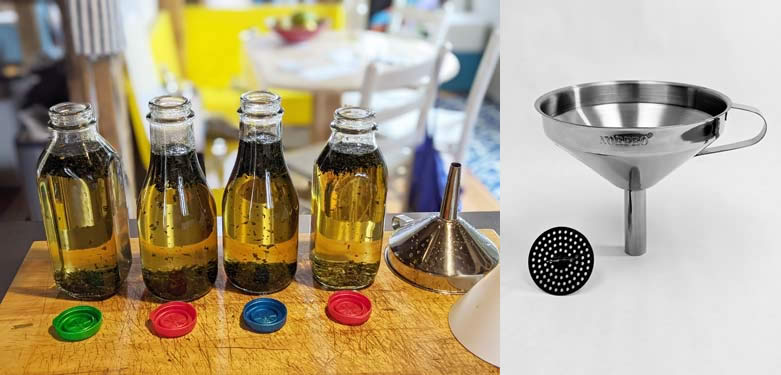
Can you freeze milk in a glass bottle?
All forms of milk (cow's milk, breastmilk, and plant-based milk, etc.) can be frozen in glass milk bottles for future consumption. According to the FDA guidelines, a safe rule of thumb for the duration of freezing is generally 3 months. Your freezer temperature should maintain a constant temperature of 0 degrees fahrenheit to properly preserve dairy and other milk products. Be sure to wash your glass milk bottle with soap and hot water before adding milk, and freeze the perishable milk right away. It's a good practice to leave a 2-3oz gap in the top of your glass milk bottle to allow for expansion during the freezing process and to prevent glass breakage. Place a cap securely on your glass bottle, and label it with the date. (Wax pens write effectively on glass, and wipe clean with a damp cloth.)
The safest way to thaw frozen milk is to place it in the refrigerator overnight. You can alternatively hold the bottle under cool running water. Don't thaw milk at room temperature, and avoid the microwave, as it unevenly heats food molecules and greatly contributes to a reduction in nutritional value. It is particularly unsafe to thaw/heat breastmilk for infant consumption in a microwave.
For more specific information about safely freezing milk and other food items, refer to the FDA's pamphlet entitled "Food Facts from the U.S. Food and Drug Administration." access it here: https://www.fda.gov/media/80676/download
For more specific information on freezing and thawing breastmilk, consult La Leche League International's resource The Womanly Art of Breastfeeding.
Using glass milk bottles for freezing has both advantages and disadvantages. On the positive side, glass is a non-reactive material, meaning it does not leach any harmful chemicals into the contents, making it a safe option for storing food and liquids. Glass milk bottles are also environmentally friendly as they are reusable and recyclable, contributing to a reduction in single-use plastic waste. Additionally, glass provides excellent insulation, helping to maintain the temperature of the frozen milk and preventing freezer burn. This ensures that the milk retains its quality and taste when thawed.
However, there are drawbacks to using glass milk bottles for freezing. One significant disadvantage is the risk of breakage. Glass is more fragile than plastic, and when exposed to extreme temperature changes, it can crack or shatter. This can result in not only a loss of the frozen milk but also potential safety hazards with broken glass in the freezer. Glass bottles are also heavier and bulkier than their plastic counterparts, making them less convenient for storage and transportation. Moreover, glass may take longer to freeze and thaw compared to plastic, which could be a consideration for those looking for quick and efficient freezing options. Our thick glass milk bottles are better for freezing than a mason jar.
Using smaller bottles to freeze often results in less breaking. Half gallons are the most likely to break and crack when placed in the freezer due to the volume of liquid inside. **If you choose to freeze liquid in glass milk bottles Red Hill General Store will not refund or replace due to cracking or breaking. Freeze at your own risk**
Best container to store milk?
Glass milk bottles are the best container to store milk, in terms of safety, nutritional quality, expense, and convenience. (This is true for cow's milk, breastmilk, and cow's milk alternatives, including but not limited to: soymilk, almondmilk, and oatmilk.) Glass bottles lack the toxic chemicals and carcinogens inherent in plastic containers. Learn more about the dangers of plastic toxins here. Additionally, glass milk bottles preserve the nutritional quality of milk for longer periods of time when compared to the cardboard and plastic alternatives. This is due to glass' unparalleled ability to seal better and stay cooler. (Be sure to place glass bottles in the back of the fridge, instead on the door, to reduce exposure to temperature fluctuations.) Further, less milk is discarded when stored in refrigerated glass bottles due to an increase in its duration of freshness. Less waste results in less expense, and creates mutual benefits for both the producer and the consumer. Lastly, glass bottled milk provides environmentally-sound convenience for the consumer, as they are easy to reuse for future milk purchases or refrigerated storage. Glass milk bottles are versatile in function and can be repurposed to efficiently store grains or beans, steep herbal infusions, ferment excess cabbages, or hold flowers for aesthetic appeal. They are also desirable items for second hand sales and readily recyclable in most locations.
Best Breast Milk Storage Containers
Glass milk bottles are the safest container for storing expressed breastmilk for baby's future consumption. Using glass for breastmilk storage eliminates the dangers of toxins commonly found in plastic storage containers, including, but not limited to: plastic bags (even those specifically labeled for breastmilk storage) and plastic baby bottles. Phthalates, carcinogens found commonly in plastics, are linked to reproductive harm and impaired neurological development in children and a wide range of health problems across all ages and stages of human development. "When the advocacy organization Environment California tested five leading brands of baby bottles, it found that all five bottles leached BPA when they were subjected to the temperatures reached in most dishwashers. The levels of leached BPA were equal to those that caused harm in laboratory animals" (Source: Ina May Gaskin, Ina May's Guide to Breastfeeding, pp. 166-167.)
In addition to their unparalleled safety characteristics glass milk bottles are a versatile choice for breastmilk storage. A covered glass milk bottle containing freshly expressed breastmilk can safely sit on your kitchen counter for four hours at room temperature and remain fresh for the baby's next feeding. Glass bottled and sealed breastmilk can be safely refrigerated for at least three days and safely frozen for at least three months. Learn more about freezing milk here. Placement of your glass bottled breastmilk while storing is important: the back portions of both the refrigerator and the freezer experience less temperature fluctuations than the door shelves or the sides of the compartment. Bottled breast milk or any raw milk should be stored in the back of the fridge or freezer.
Glass bottled breastmilk can be safely and easily prepped for baby's consumption after proper storage in the refrigerator or freezer. To thaw, place the glass bottle in the fridge overnight. To warm, hold the glass bottle under warm running water, or place the glass bottle in a small basin of warm water for five minutes. Taking the chill off the glass bottled milk to suit a nursling's affinity for body temperature milk is efficient. Be cautious with heat, and avoid warming your glass bottled milk in the microwave: unevenly heated breastmilk can result in the scalding of an infant's mouth, and the act of microwaving can result in a reduction of the nutritious qualities inherent in the breast milk.
(For more specific details on pumping, storing, freezing, and thawing breastmilk for infant consumption, consult La Leche League International's resource The Womanly Art of Breastfeeding.)
What Is The Healthiest Milk For Humans?
The healthiest milk for consumption varies from individual human to individual human and is dependent on age, health, and allergy status. Cow's milk and two plant-based alternatives: soy milk and almond milk take up a lot of space in the marketplace. (Other less widely consumed milks include goat's milk, oat milk, flax milk, hemp milk, and cashew milk.) For the developing human, breastmilk is an unparalleled nutrient source and immune system protectant for many reasons.
It's well-known that cow's milk is the most popular milk on the market and serves as a healthy cornerstone in a well-balanced, nutrient-dense diet. Cow's milk is readily available in a variety of forms, including but not limited to: cream, whole, 2%, 1%, and skim. Rapidly developing, active children and adolescents generally require more caloric intake and healthy fat in their diets, rendering a fat ratio higher than skim as a good choice. On the contrary, the average adult interested in maintaining his healthy weight and body mass should lean towards a skimmed variety. Generally speaking, pasteurized and ultra-pasteurized supermarket or farm varieties are considered the safer alternatives to the less widely spread practice of consuming raw dairy. Pasteurization alters the enzymatic components of the original milk, but it also decreases the risk of bacterial contamination and increases the longevity of the milk.
In terms of nutrients, cow's milk is well-known for providing protein and calcium, in addition to a variety of other vitamins and minerals (including the immune system boosting mineral known commonly referred to as zinc.) Milk's bone-building calcium has been linked to osteoporosis prevention for decades and to healthy bone development in youngsters for just as long. According to Marongoni, et. al., in "Cow's Milk Consumption and Health," milk proteins "contain all the essential amino acids required by the human body, and because of their high digestibility and bioavailability." More simply put, current scientific studies indicate what hard-working, milk-drinking folks have known for millennia: milk is beneficial to all ages and developmental stages (except in the case of dairy-related allergies).
Learn more about cow's milk and your health here.
For individuals with dairy allergies or dietary restrictions, soy milk and almond milk are two healthy plant-based alternatives. Soy milk is known for being a high quality protein source that is lower in fat, carbs, and calcium than cow's milk and serves as an adequate nutrient source in malnourished populations where cow's milk is less readily available. Due to the lack of calcium present in soybeans, it's important to choose a calcium-enriched brand when consuming soy milk as a single alternative to cow's milk. Almond milk is another plant-based alternative to cow's milk that is both nutrient-dense and lower in fat. Its high fiber and low sodium content also render it an excellent option for individuals managing cardiovascular health.
Learn more about soymilk here: https://www.researchgate.net/publication/330727127_Soymilk_as_source_of_nutrient_for_malnourished_population_of_developing_country_A_review Learn more about almond milk here:https://www.researchgate.net/publication/325975993_Nutritional_and_Sensory_Properties_of_Almond_Prunus_amygdalu_Var_Dulcis_Seed_Milk For the growth and development of infants and toddlers, breastmilk is superior to all other forms of milk. The World Health Organization (WHO) recommends exclusive breastfeeding until 6 months of age. The iron-stores in mother's milk are depleted within 6 months time, and the introduction of iron-rich complementary foods is important. Cow's milk is not rich in iron; so, it is recommended that routine consumption of cow's milk be delayed until after 12 months of age when the toddler is typically consuming iron-rich or iron-fortified foods as part of her daily diet. Continued breastfeeding is important through the second year of life, and if the mother and toddler are agreeable to an extended experience, benefits expand beyond year 2.
Breastmilk is unparalleled in its immune system building abilities, which are particularly important for infants and very young children. As a dynamic and raw food, it does far more than provide sufficient caloric intake for a rapidly growing infant. Breastmilk components vary from mother to mother and day to day. For example, a sick infant will initiate an infiltration of specific immune system factors from her mother's bloodstream directly into her mother's breastmilk. (Mothers often notice a change in the color of their milk when this happens, from pale white to a darker yellow, indicating antibody-rich milk.) Additionally, the healthy bacteria found in breastmilk, directly contributes to the development of a balanced, infection-fighting flora in the infant gut.
To protect the exceptional nutritive and disease-fighting components of breastmilk, use glass milk bottles, instead of plastic materials, for storage. Learn more about best breastmilk storage containers here.
What Do You Fill Old Milk Bottles With?
You can fill old milk bottles with anything small enough to fit in them.
Check out our blog post with examples of filling milk bottles with dry food, napkins, candies, pocket change, and office supplies.
Check out our list of 101 uses for Glass milk bottles.
Making Weekend Teas: Great for brewing and serving your favorite teas hot or hold.
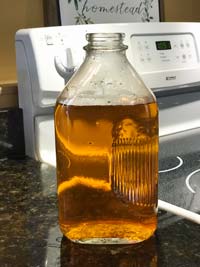
DIY Vanilla
You will need:
Half pint glass bottles
Vanilla beans
Vodka
Procedure:
Cut vanilla beans so they will fit inside mini milk bottles. Place them inside the bottles and fill to the top with vodka, covering the vanilla beans. In 6-12 months your homemade vanilla will be ready for regular use.
